Erd Diagram In Software Engineering
Entity-Relationship Diagrams
ER-modeling is a data modeling method used in software engineering to produce a conceptual data model of an information system. Diagrams created using this ER-modeling method are called Entity-Relationship Diagrams or ER diagrams or ERDs.
Purpose of ERD
- The database analyst gains a better understanding of the data to be contained in the database through the step of constructing the ERD.
- The ERD serves as a documentation tool.
- Finally, the ERD is used to connect the logical structure of the database to users. In particular, the ERD effectively communicates the logic of the database to users.
Components of an ER Diagrams
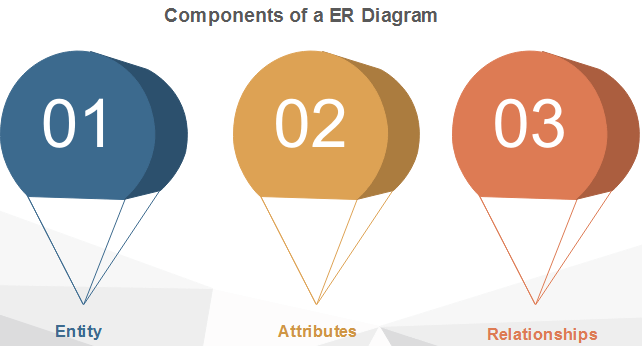
1. Entity
An entity can be a real-world object, either animate or inanimate, that can be merely identifiable. An entity is denoted as a rectangle in an ER diagram. For example, in a school database, students, teachers, classes, and courses offered can be treated as entities. All these entities have some attributes or properties that give them their identity.
Entity Set
An entity set is a collection of related types of entities. An entity set may include entities with attribute sharing similar values. For example, a Student set may contain all the students of a school; likewise, a Teacher set may include all the teachers of a school from all faculties. Entity set need not be disjoint.

2. Attributes
Entities are denoted utilizing their properties, known as attributes. All attributes have values. For example, a student entity may have name, class, and age as attributes.
There exists a domain or range of values that can be assigned to attributes. For example, a student's name cannot be a numeric value. It has to be alphabetic. A student's age cannot be negative, etc.
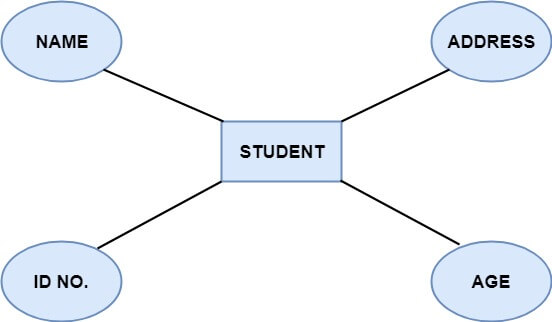
There are four types of Attributes:
- Key attribute
- Composite attribute
- Single-valued attribute
- Multi-valued attribute
- Derived attribute
1. Key attribute: Key is an attribute or collection of attributes that uniquely identifies an entity among the entity set. For example, the roll_number of a student makes him identifiable among students.
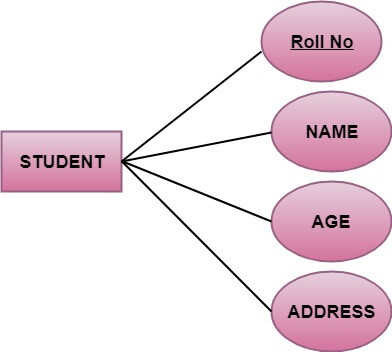
There are mainly three types of keys:
- Super key: A set of attributes that collectively identifies an entity in the entity set.
- Candidate key: A minimal super key is known as a candidate key. An entity set may have more than one candidate key.
- Primary key: A primary key is one of the candidate keys chosen by the database designer to uniquely identify the entity set.
2. Composite attribute: An attribute that is a combination of other attributes is called a composite attribute. For example, In student entity, the student address is a composite attribute as an address is composed of other characteristics such as pin code, state, country.
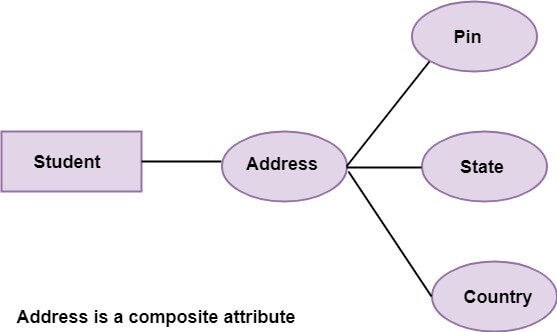
3. Single-valued attribute: Single-valued attribute contain a single value. For example, Social_Security_Number.
4. Multi-valued Attribute: If an attribute can have more than one value, it is known as a multi-valued attribute. Multi-valued attributes are depicted by the double ellipse. For example, a person can have more than one phone number, email-address, etc.
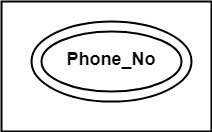
5. Derived attribute: Derived attributes are the attribute that does not exist in the physical database, but their values are derived from other attributes present in the database. For example, age can be derived from date_of_birth. In the ER diagram, Derived attributes are depicted by the dashed ellipse.
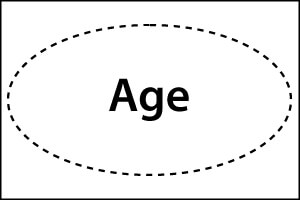
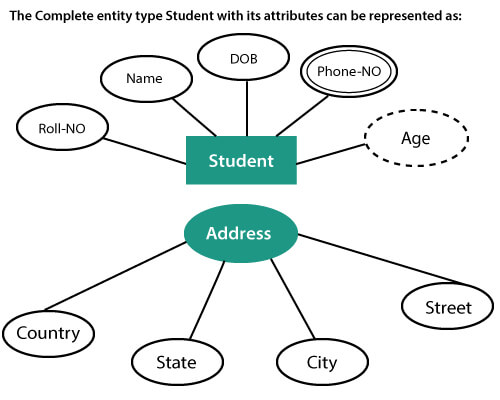
3. Relationships
The association among entities is known as relationship. Relationships are represented by the diamond-shaped box. For example, an employee works_at a department, a student enrolls in a course. Here, Works_at and Enrolls are called relationships.

Relationship set
A set of relationships of a similar type is known as a relationship set. Like entities, a relationship too can have attributes. These attributes are called descriptive attributes.
Degree of a relationship set
The number of participating entities in a relationship describes the degree of the relationship. The three most common relationships in E-R models are:
- Unary (degree1)
- Binary (degree2)
- Ternary (degree3)
1. Unary relationship: This is also called recursive relationships. It is a relationship between the instances of one entity type. For example, one person is married to only one person.
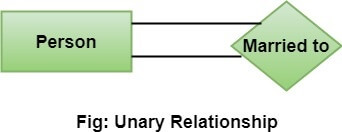
2. Binary relationship: It is a relationship between the instances of two entity types. For example, the Teacher teaches the subject.

3. Ternary relationship: It is a relationship amongst instances of three entity types. In fig, the relationships "may have" provide the association of three entities, i.e., TEACHER, STUDENT, and SUBJECT. All three entities are many-to-many participants. There may be one or many participants in a ternary relationship.
In general, "n" entities can be related by the same relationship and is known as n-ary relationship.
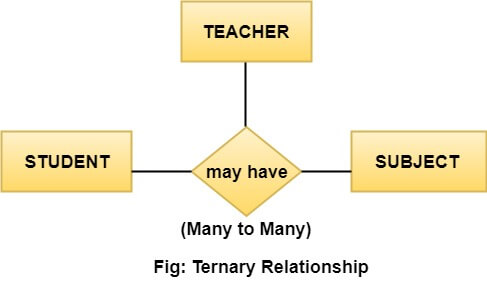
Cardinality
Cardinality describes the number of entities in one entity set, which can be associated with the number of entities of other sets via relationship set.
Types of Cardinalities
1. One to One: One entity from entity set A can be contained with at most one entity of entity set B and vice versa. Let us assume that each student has only one student ID, and each student ID is assigned to only one person. So, the relationship will be one to one.

Using Sets, it can be represented as:
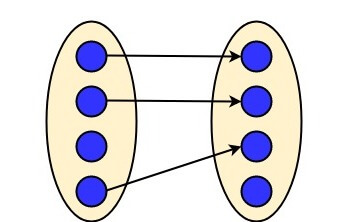
2. One to many: When a single instance of an entity is associated with more than one instances of another entity then it is called one to many relationships. For example, a client can place many orders; a order cannot be placed by many customers.

Using Sets, it can be represented as:
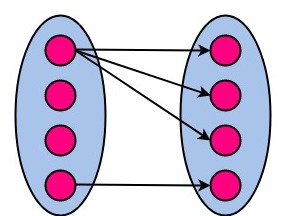
3. Many to One: More than one entity from entity set A can be associated with at most one entity of entity set B, however an entity from entity set B can be associated with more than one entity from entity set A. For example - many students can study in a single college, but a student cannot study in many colleges at the same time.

Using Sets, it can be represented as:
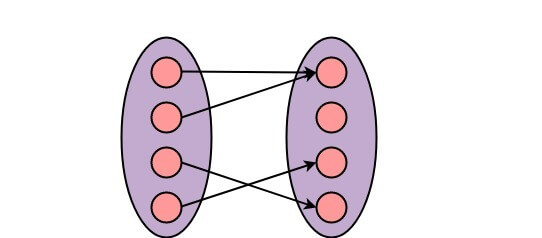
4. Many to Many: One entity from A can be associated with more than one entity from B and vice-versa. For example, the student can be assigned to many projects, and a project can be assigned to many students.

Using Sets, it can be represented as:
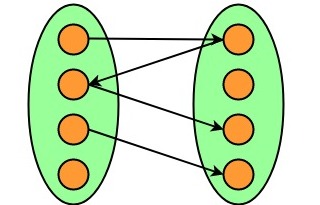
Source: https://www.javatpoint.com/software-engineering-entity-relationship-diagrams
Posted by: angleaangleaolivearriaea0252211.blogspot.com
Post a Comment for "Erd Diagram In Software Engineering"